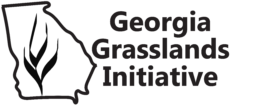“It is time for native landscapes – and knowledge about how to foster them – to become mainstream.”
We are the State Botanical Garden of Georgia. We and our partners have 27 years of conservation, horticulture, restoration experience and expertise addressing the loss of biodiversity in Georgia. We talk ourselves hoarse with great passion about these issues with every presentation, every class, every article. We need to reach a wider audience. We need a bigger microphone. We need to do this now. We are actually running out of time for some plant and animal species.
We know what needs to be done and how to do it.
And small changes will have exponential impacts to the good. We are talking about steps, tasks that are doable, and doable by everyone that science has shown will significantly benefit wildlife and biodiversity.
We want to change the Status Quo about gardening and managing land all over Georgia.
Example — Meatball shrubs and mulch is the status quo and really it is not low maintenance.
We can do better.
Problems that must change – and we have 20-30 years before we lose bird, bee, butterfly species in Georgia due to loss of native plants on the land. But if we could get these things to change, then…!
We are still having to make the case that there are invasive pest plants that cause real ecological and economical harm. Invasive pest plants are not just weedy, they are harmful to plant community diversity and therefore to wildlife. These are legal terms – invasive, noxious, pest plant with strict parameters and a thorough scientific vetting before listing.
People think unmowed is uncared for (relates to back-slopes on roadsides, beyond the safety strip, places for plant diversity to support animal diversity). We need to change how people see and regard unmowed grasslands in Georgia.
People think all green is good. (Privet is not good. English Ivy growing up a tree and going to seed is not good. Nandina kills Waxwing birds.)
People think native plants gardens are messy and wild. (No, they can be formal in design and like any garden design, need to be maintained if you want to keep that design.)
People think lawns in a perfect monoculture are prestigious, the goal, the mark of success as homeowner. (Ecologically perfect lawns are high maintenance, maintaining a single species requires a lot of chemical resources and especially in the SE US, and we can do better.)
People think Georgia’s natural areas are forests. (They are actually better represented as a mosaic of habitats with vast areas of woodlands – widely spaced trees where the sun reaches the ground supporting grasses, forbs, shrubs, and with vast areas of prairies – large expanses of grasses, forbs, pockets of shrubs and small trees, open space. Walking across only brown crunchy leaves or pine needles in the growing season under trees in a forest is not healthy habitat in Georgia.)
People think they have to till the soil all the time, every time, to plant and garden and restore land. (Breaking soil releases the seed bank, some seeds good and some seeds bad, and exposes soil to invasive pest plants and destroys/disturbs the community of organisms living in the soil.)

